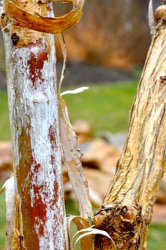
One of the most valuable tools in gardening is keeping a journal. Jotting down notes about weather and bloom times makes for fascinating reading a few years later and helps in planning the garden as you can see where there are dreary gaps in blooms that need to be filled in.
My journal keeping has been dismally sporadic, I wish I'd been more thorough. I found notes from March 14th 2007, a Wednesday, and read that it was:-
"78 degrees today -- insanely, wonderfully warm. I wish I could have spent the day outside, but did get out to prune for an hour in the morning. The tail end of pruning season, we pruned back old butterfly bushes and cut out old and crossing branches of the Heptacodium miconioides at the Barnes. It’s one of my favorite trees, with a great bark in the winter, creamy white fragrant flowers in late summer followed by bright pink calyces that are even more striking than the flowers. Seeds are doing great -- tomatoes, eggplant, cabbages and peppers have all germinated. Time for the next round.."
Seven years on it's 20 degrees cooler, drizzling, I haven't finished my pruning chores, seeds have JUST been sown and are no where near germinating. Ah well, Heptacodiaum miconioides is still one of my favorites and the specimen I planted in our garden is doing splendidly.
The Facts
Family: Caprifoliaceae (Honeysuckle Family)
Genus: Heptacodium
Species: miconioides
Common Name: Seven Son’s Flower, Heptacodium
Area of Origin: China
Characteristics: It's a small tree (usually around 15 to 20′ tall although ours is already reaching this), whose branches arch slightly but can be leggy with age. The leaves are opposite, entire, ovate with heart-shaped bases and acuminate tips. There is no fall color to speak of, but the pink sepals provide wonderful autumn interest and the leaves hold late into the season. The flowers are fragrant and can be either white or a soft pink and hold up through the heat of August to first frosts. The sepals continue to grow as the flower fades and are a gorgeous vibrant pink. The bark is beautiful; lots of texture and peeling with deep rich browns.
Hardiness: USDA Zones 5 to 8.
Cultivation needs: Fairly adaptable -- although the one at the Barnes is wedged between the parking lot and road and does not look too healthy. It grows in full sun to part shade, likes well drained soil (loves our slope) and tolerates some drought. It prefers a slightly acidic soil.
Typical Pests, Diseases, associated problems: Nothing serious I know of.
Propagation Method: Its meant to root easily from softwood cuttings and can also be grown from seed Both would take years, and it is now widely available at good nurseries which is a much faster way to enjoy it in your garden.
My journal keeping has been dismally sporadic, I wish I'd been more thorough. I found notes from March 14th 2007, a Wednesday, and read that it was:-
"78 degrees today -- insanely, wonderfully warm. I wish I could have spent the day outside, but did get out to prune for an hour in the morning. The tail end of pruning season, we pruned back old butterfly bushes and cut out old and crossing branches of the Heptacodium miconioides at the Barnes. It’s one of my favorite trees, with a great bark in the winter, creamy white fragrant flowers in late summer followed by bright pink calyces that are even more striking than the flowers. Seeds are doing great -- tomatoes, eggplant, cabbages and peppers have all germinated. Time for the next round.."
Seven years on it's 20 degrees cooler, drizzling, I haven't finished my pruning chores, seeds have JUST been sown and are no where near germinating. Ah well, Heptacodiaum miconioides is still one of my favorites and the specimen I planted in our garden is doing splendidly.
The Facts
Family: Caprifoliaceae (Honeysuckle Family)
Genus: Heptacodium
Species: miconioides
Common Name: Seven Son’s Flower, Heptacodium
Area of Origin: China
Characteristics: It's a small tree (usually around 15 to 20′ tall although ours is already reaching this), whose branches arch slightly but can be leggy with age. The leaves are opposite, entire, ovate with heart-shaped bases and acuminate tips. There is no fall color to speak of, but the pink sepals provide wonderful autumn interest and the leaves hold late into the season. The flowers are fragrant and can be either white or a soft pink and hold up through the heat of August to first frosts. The sepals continue to grow as the flower fades and are a gorgeous vibrant pink. The bark is beautiful; lots of texture and peeling with deep rich browns.
Hardiness: USDA Zones 5 to 8.
Cultivation needs: Fairly adaptable -- although the one at the Barnes is wedged between the parking lot and road and does not look too healthy. It grows in full sun to part shade, likes well drained soil (loves our slope) and tolerates some drought. It prefers a slightly acidic soil.
Typical Pests, Diseases, associated problems: Nothing serious I know of.
Propagation Method: Its meant to root easily from softwood cuttings and can also be grown from seed Both would take years, and it is now widely available at good nurseries which is a much faster way to enjoy it in your garden.

 RSS Feed
RSS Feed
